Growing vegetables is something that many people strive for. If you want to learn how to grow vegetables in your garden, this detailed guide is exactly what you need. It covers everything from getting started, benefits, techniques, designing and planning, all the way through planting, care, and harvesting.
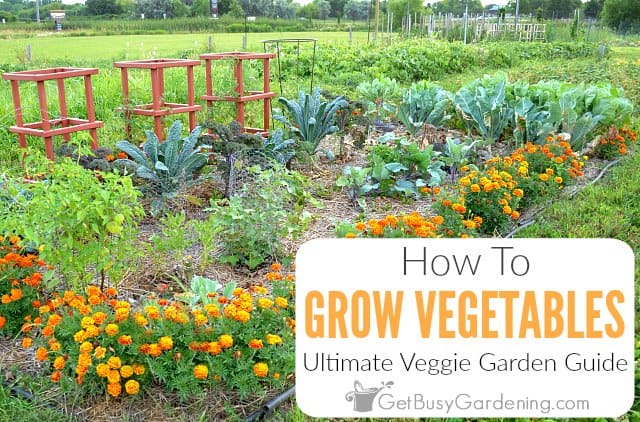
How do you start a vegetable garden? If you’re looking for all the answers about growing your own vegetables, then you’re in the right place!
Once you discover just how easy it can be to grow vegetables yourself, you’ll be excited to get started.
Growing vegetables is a huge topic though, and I can’t possibly cover every single detail in one article.
So, this guide will be the starting point for everything you need to know about how to grow fresh vegetables in your garden.
In this detailed vegetable growing guide I’ll lay it all out for you in bite-sized pieces. I also included links to additional articles where you can learn all about the more detailed topics.
Growing Vegetables For Beginners
If you’ve never grown your own vegetables before, you may feel nervous or overwhelmed. Don’t worry, you’re not alone!
The thought of spending tons of time or money, and then possibly failing, is a common concern for beginners.
The dream of growing your own vegetables is very alluring, and it’s easy to get excited about planting everything. But maintaining a veggie garden can take some time to get the hang of.
The most common mistake that new gardeners make is trying to do too much. So, my biggest piece of advice is to start small.
Choose a couple of your favorite veggies to grow, and then plant them in an existing garden bed.
Or better yet, grow a few containers of vegetables on your deck or patio. Then you can expand your garden as you gain more confidence.
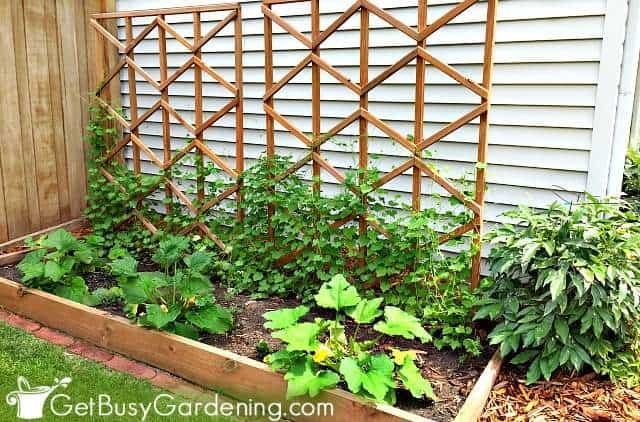
Benefits Of Growing Vegetables
Growing vegetables in your own backyard is not only fun, there are tons of benefits too. Here are a few of the most important ones…
- Healthy – Tending to your vegetable patch is good exercise, and gets you outside. Plus, you will eat what you grow. Which means you and your family will probably be eating more veggies than usual.
- Saves money – Growing your own vegetables will help reduce the cost of your grocery bill. You can grow organic produce for much less than what you’d pay at the supermarket.
- Helps the environment – Planting a veggie garden is a great way to reduce your carbon footprint. Plus, backyard vegetable gardens help to support bees and other endangered pollinators.
- Tastes better – If you’ve ever eaten a warm, juicy tomato or strawberry right out of the garden, you know that nothing beats the taste of homegrown! Veggies you buy at the grocery store simply do not taste as good as the ones you grow in your own backyard.
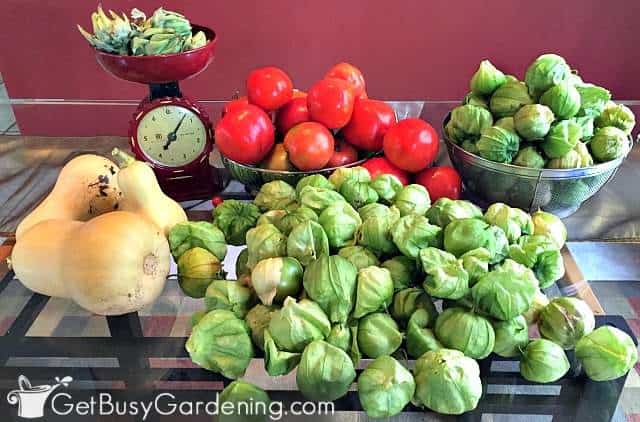
Growing Techniques For Vegetable Gardeners
There are lots of ways to grow vegetables, even if you don’t have a yard or garden. Below I’ve listed several techniques that you can try.
Each one has its own unique benefits, and many of these techniques can be combined to grow even more vegetables. Here are a few of the most popular growing techniques for vegetable gardeners, and their benefits…
Vertical Gardening
The biggest benefit of growing vegetables vertically is that you can grow more food in less space. Plus, when you grow your crops up and off the ground, they are less prone to pest and disease issues.
You can get really creative with it too (which is my favorite thing to do). Use fun supports to trellis climbing vegetables in your garden.
Or grow vegetables in hanging pots or vertical planters on your patio or deck. Learn all about growing vertically here.
Pots & Containers
Most types of vegetables can be grown in pots, which means you can grow a vegetable garden anywhere.
There are tons container-sized veggie plants that are made specifically for in pots. So you can grow all of your favorites.
You don’t even need to have a yard or garden! Plant veggies on your patio, deck, balcony or even the driveway if that’s where you have the most sun. Learn more about container gardening here.
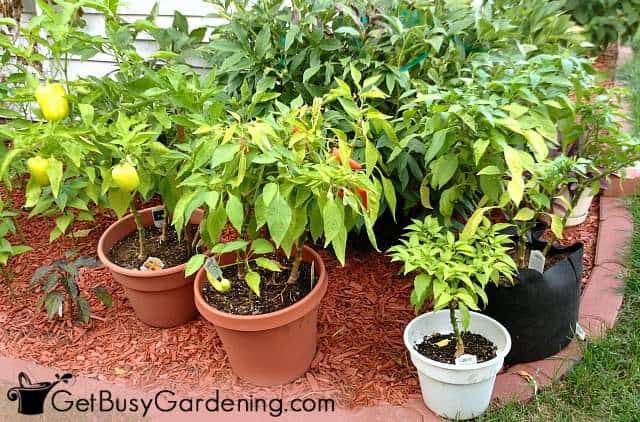
Raised Beds
If you have poor quality soil, or the ground consists of rocks or roots, then raised beds are the solution.
Raised beds also make it a snap to get started. No need to dig up any grass or till the soil, just build it right on top.
Raised beds also make maintenance easier. Since your vegetable plants are contained within the beds, you don’t have to weed and water the entire garden plot.
Crop Rotation
If you plant everything in the same spot year after year, it can cause major problems in your veggie patch. That’s where crop rotation comes into play.
Rotating your plantings every year is important to help everything stay healthy. For example, some pests and diseases only attack certain crops. So rotating your plants will help to prevent recurring issues.
Also, some vegetable plants are heavy feeders which can quickly deplete the nutrients in the soil. While other vegetables will add nutrients back into the soil.
Planting crops in different spots every year will help to prevent nutrient deficiencies.
Succession Planting
If you plant all of your veggies at the same time, they will start producing at the same time. So why not spread it out a little with succession planting.
The term succession planting means spreading out the timing of planting your vegetables. Which means your harvests will also be spread out.
Your veggie garden will produce for longer, and you won’t be so overwhelmed at harvest time.
It’s also a great way to make the most of your space. You can interplant fast growing crops (like salad greens) with slower ones (like brussels sprouts or beans).
Then, after you’re done harvesting your early vegetables, the late crops will fill in – giving them plenty of room to grow.
Companion Planting
Some vegetables grow well together, and some do not. So, in order to have the most amazing vegetable garden you possibly can, it’s a good idea to learn about companion planting.
Companion planting is grouping vegetables that benefit each other together, and avoiding any bad combos.
For example, good companions can enhance a vegetables flavor, attract pollinators, or provide shade for heat-sensitive crops.
If you’re new to growing vegetables, don’t get overwhelmed by this. Companion planting is a huge, and very advanced topic.
But it’s fun to experiment once you get more experience. If you’re interested in learning more, read my beginner’s guide to companion planting.
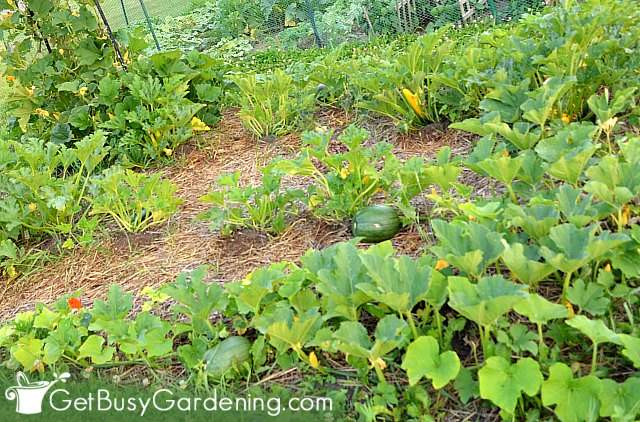
Tips For Starting A New Vegetable Garden
There are a few important things to keep in mind when starting a DIY vegetable garden from scratch. The most important ones are the size, location, and the soil. Here are a few quick tips for getting started…
- Size – If you’ve never tried to grow your own vegetables before, remember to start small. Rather than digging a new bed, try planting a few veggies in your flower beds, or growing them in containers.
- Location – Most types of vegetables grow best in an area that has good drainage and gets full sun. So choose a location that gets at least 6 hours of direct sunlight. Also, be sure to avoid areas where water pools in your yard, especially if you have clay soil.
- Soil – When it comes to growing vegetables, everything starts with the soil. You can’t grow vegetables that are healthy and productive without good soil. So be sure to always test your soil, and amend it as necessary. It’s easy to do with a home soil test kit.
Design Tips
Creating your own vegetable garden design doesn’t have to be complicate, and you don’t need to buy any fancy software.
To make it easy, just grab a piece of paper and a pencil, and draw a rough sketch of your space.
Next, decide what techniques you will incorporate into your design (vertical gardening, raised beds, containers…etc) and add them to your drawing.
If you’re not ready to try any of those, then you can just plant in traditional rows.
Just be sure to add some paths onto your sketch so you will have plenty of room for maintenance and harvesting. Learn how to design your veggie garden step-by-step here.
Once you have a sketch of your layout, you’ll know how much space you have for growing a vegetable patch. Now you can take that and start planning what vegetables you will grow.
Planning
Planning what you want to grow in your vegetable garden before you start planting will be much easier, and less stressful for you.
If you go out and buy all those plants or grow a ton of seedlings, only to realize you don’t have enough space for everything… well, it can be very frustrating.
Choosing what to grow can be stressful for some. If you’re struggling to figure it out, here’s how to decide what to plant in a vegetable garden.
If you’re new to growing a veggie garden, start with this list of the easiest vegetables to grow. Remember to start small, and just plant a few of your favorites so you don’t get overwhelmed.

How To Grow Vegetables
Planning and designing your veggie patch is one thing. But learning how to make vegetables grow is usually where the anxiety can kick in.
Don’t worry though. Because when you break if down, it’s not very complicated. There are three main phases for growing a vegetable garden – planting, care & maintenance, and harvesting.
So, to make this super easy for you, below I’ll talk in detail about each one. I’ll give you tons of vegetable growing tips, tell you what to do in each phase, and share links to related articles so you can read even more information. Here we go…
Planting
Once you’re done designing and planning, now comes the fun part… planting everything! Below are a few easy tips for you.
- Before getting started– Make sure the soil is damp but not soggy. If it’s dry, then water it the night before you start planting. If it’s saturated or really sticky, then wait until it dries out a bit before planting your veggies.
- Preparing the soil – Before planting any vegetables, you should prepare the soil. Now’s the time to add in any amendments the soil needs. Then loosen it up by tilling or turning it, removing any grass or weeds that are present. Learn exactly how to prepare your vegetable garden soil here.
- When to start planting – It’s important to plant each type of veggie at the right time. You need to find your growing zone in order to know exactly when to start. Look it up, or ask your local garden center for your average last frost date.
- Plant spacing – Vegetables need plenty of room to grow. Crowding your plants can stunt their growth, which means a smaller harvest (or no harvest at all). So be sure to follow the planting instructions on the seed packet or plant tag, and give your veggies plenty of space to grow and produce.
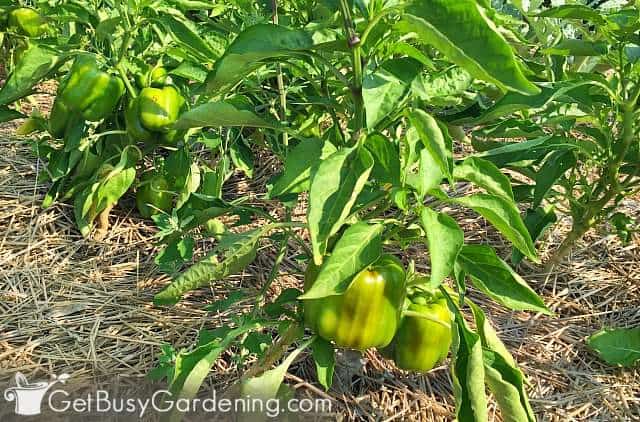
Care & Maintenance
There’s no doubt that growing vegetables will take some time and work. But it’s not too difficult, and there are lots of shortcuts you will learn as you go.
The three biggest struggles you’ll face with growing your own vegetable garden are watering, and controlling weeds and pests. To get you started, here are some quick care tips…
- Watering – Vegetables need a lot of water in order to produce healthy crops. Inconsistent watering can cause problems like blossom end rot or cracking. Improper watering can also cause issues with mildew and disease. Learn all about watering your vegetable garden here.
- Fertilizing – Many types of veggies are heavy feeders, and need to be fertilized regularly in order to produce the best and biggest bounty. Skip the chemical brands though, natural and organic products work much better. Learn how to fertilize your vegetable garden here.
- Weed control – Weeds not only look bad, they can steal nutrients, water, and sunlight from your vegetables. The best way to control the weeds is to lay mulch, which prevents them from growing in the first place. Learn how to mulch a vegetable garden here.
- Controlling pests – Another huge struggle with growing vegetables is keeping bugs and animals from enjoying your crops before you can. But one important thing to remember is that only a handful of bugs are actually bad. So, the best thing to do is keep a balance between the good bugs and the bad bugs. Learn more about garden pest control here.
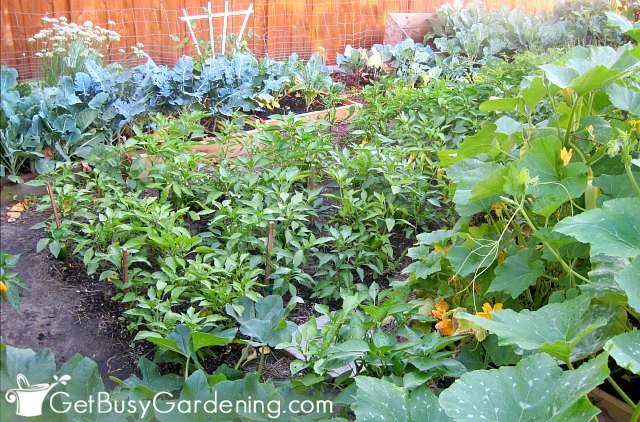
Harvesting
Once your veggies start producing, you’ll notice that some will need to be harvested more often than others.
So it’s good to know how and when to harvest the specific type of vegetables you’re growing. Learn more about harvesting vegetables here.
Here are a few things to keep in mind so you know what to expect come harvest time…
- Consistent harvest veggies – Some plants will give you a steady stream of fresh vegetables throughout their season. Crops like green beans, summer squash, peas, broccoli, salad greens, and cucumbers are a few examples.
- One-and-done vegetables – Plants that only give you one harvest are what I like to call one-and-done veggies. Examples include kohlrabi, cabbage, garlic, onions, radishes, potatoes, cauliflower, carrots, and beets.
- Cold season crops – Cool season veggies produce their crops in the cooler weather of spring and fall, and will die off in the heat of summer. A few examples are lettuce, spinach, turnips, radish, peas, and arugula.
- Warm season vegetables – Vegetables that prefer the heat will not start to produce their crops until it gets warm enough in the summer. Tomatoes, beans, squash, eggplant, cucumbers, peppers, and tomatillos are examples.
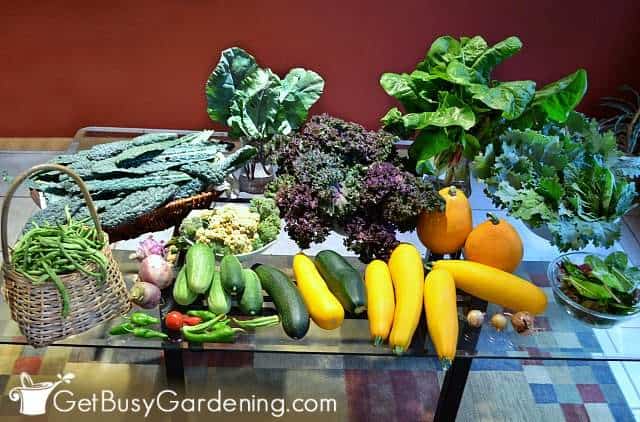
Veggie Garden Tools & Supplies
You don’t need to buy a bunch of expensive equipment to grow vegetables at home. You could easily get by with nothing but a spade shovel and your bare hands.
But there are a few things that will make it much easier for you to plant, maintain, and harvest your vegetables. Here are a few of the most important. You can see my full list of the most essential tools and supplies here.
- Spade shovel – If you only get one tool, make it a spade shovel. You’ll need it for digging of course. But you can also use it for turning the soil, planting, weeding, filling pots, and many other basic tasks.
- Clippers – If you are able to get two gardening tools, then make your second one a pair of pruning shears. You’ll find them essential when it comes time for pruning and harvesting.
- Compost – Whether your soil is clay or sandy, compost is an all-around good soil amendment. It helps to aerate the soil, retain moisture, feed your plants, and attract beneficial organisms (like worms!).
- Organic fertilizer – Always use organic fertilizers in your veggie garden. Chemicals harm the soil, can burn plants, and are bad for you. You can choose either granules or a liquid fertilizer, or combine them.
- Trowel or garden knife – You might enjoy using your hands to dig in the dirt, but you’ll find it much easier with the help of a garden knife or a hand trowel.
- Weeding tool – Weeding the garden is definitely a chore, but a weeding tool will make it so much easier.
Troubleshooting Common Problems
When it comes to growing vegetables, there are lots of issues you could run into. The good news is that all of these common problems are easily fixable.
Flowers But No Fruit
This is a sure sign that your veggies aren’t being pollinated. The best way to fix this problem is by attracting bees and other pollinators. Learn how to attract pollinators to the vegetable garden here.
Healthy Plants But No Flowers
If your vegetable plants are healthy and green, but they don’t grow any flowers, then it’s time to test the soil. It’s probably an imbalance of nutrients, like too much nitrogen or using the wrong type of fertilizer.
Vegetable Plants Didn’t Grow
This is usually caused by bad soil, lack of sun or water, or even too much sun for certain types of vegetables. Test your soil, and then check the sun exposure, and your watering habits.
Weak, Yellow, Or Unhealthy Looking Veggie Plants
This is another common problem that is likely caused by acidic or infertile soil, and can easily be fixed with simple amendments. A soil pH probe makes it super easy to check for acidity. And a quick soil test will tell you if there’s anything you need to add.
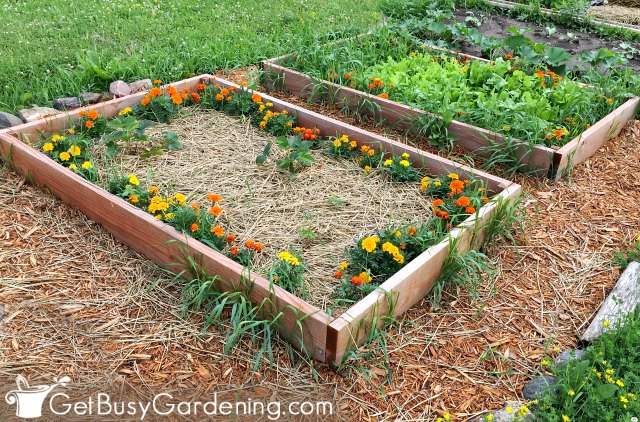
FAQs About Growing Vegetables
In this section, I’ll answer some of the most commonly asked questions about growing vegetables. If you still have a question after reading through this vegetable growing guide, and these FAQs, please ask it in the comments section below.
What are the best vegetables to grow in your garden?
This will be different for everyone, and many times it comes down to personal preference.
When should you plant your vegetable garden?
The exact vegetable planting dates depend on where you live, and what you want to grow. Plus, vegetables can be planted at different times throughout the season.
So, it’s best to follow the recommended planting times on the seed packet or plant tag.
How much sun does a vegetable garden need?
Most vegetables grow best in full sun, which means they get at least 6 hours of unobstructed sunlight per day.
How do you grow a perfect garden?
There’s no such thing as the perfect vegetable garden, so it’s a good idea to get rid of that expectation. It will really take the pressure off! Proper care: consistent watering, pest and weed control, healthy, fertile soil, and proper sun exposure, will always give you the best success.
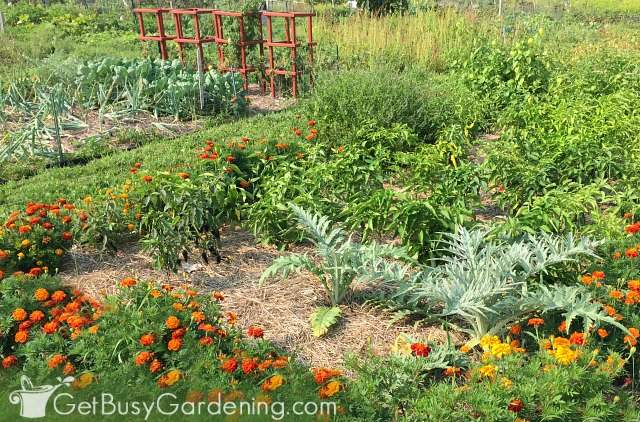
Growing vegetables in your garden is fun and rewarding. The best way to get started is to plant a few of your favorites, and add more as you gain experience. Once you see all of those vegetables growing in your garden, and you get to enjoy fresh veggies right from the plants, it will be worth every minute you spend.
If you’d like to learn how to make the most of your space and get as much homegrown food as possible, then my Vertical Vegetables book is perfect! It will teach you all you need to know, has tons of gorgeous photos, and includes 23 DIY projects you can build for your own garden. Order your copy today!
Learn more about my Vertical Vegetables book here.
More About Vegetable Gardening
- 40+ Vegetables That Grow In Shade
- 15 Colorful Vegetables To Grow In Your Garden
- Choosing The Best Mulch For Vegetable Gardens
- How To Tell Determinate vs Indeterminate Tomatoes
- Female -vs- Male Squash Flowers: How To Tell The Difference
- How & When To Plant Potatoes In Your Garden
Share your tips about growing vegetables at home in the comments section below.
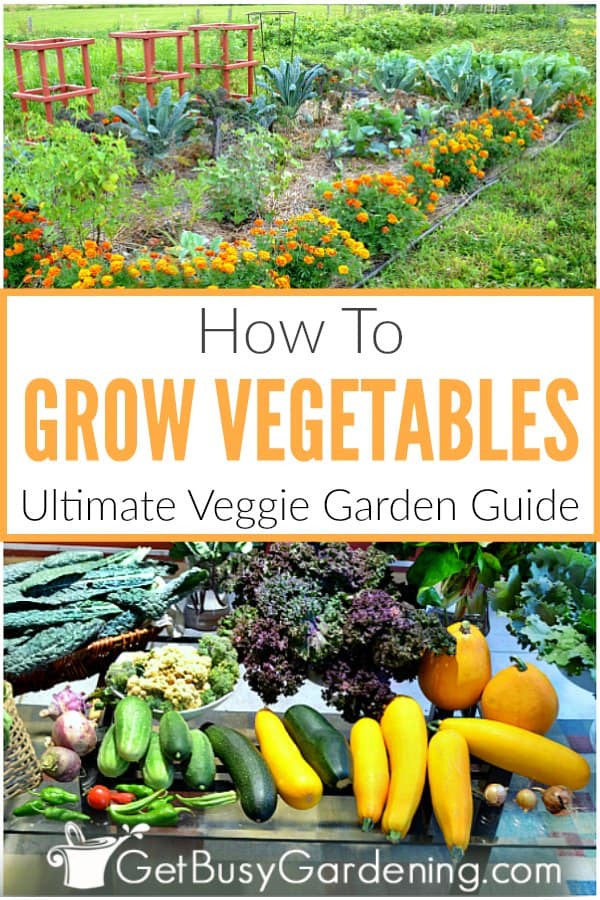
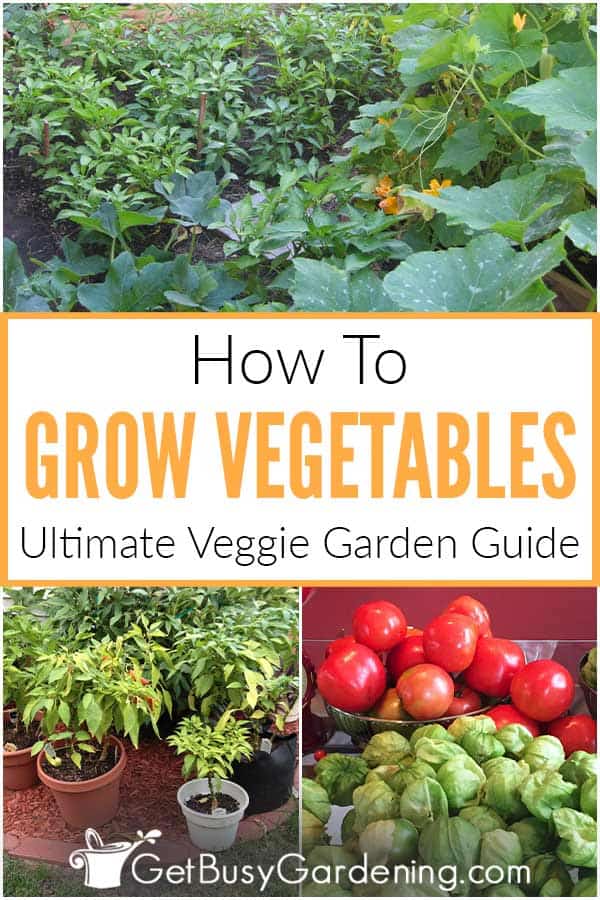

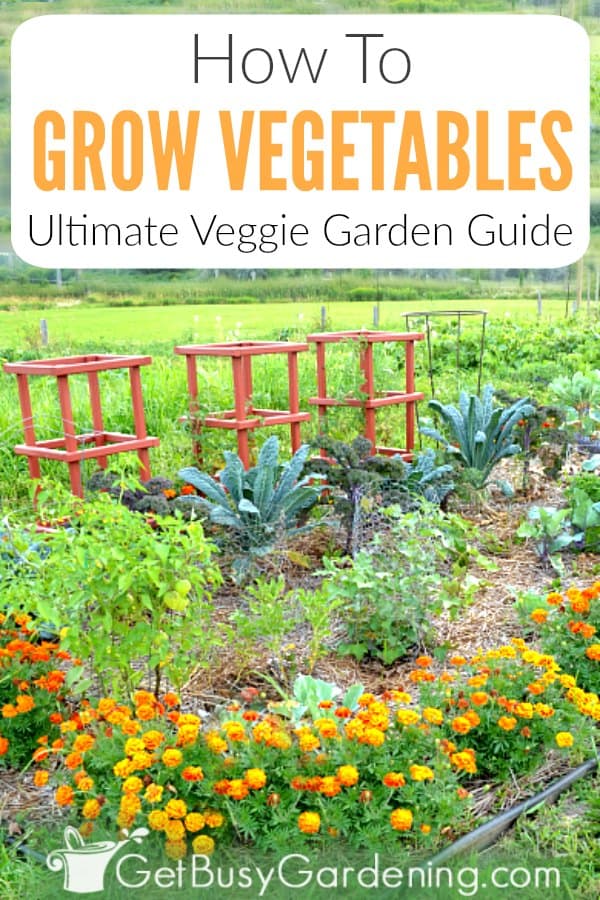



Deeann Phernetton says
“Raised beds are such a game-changer! I’ve been using them for a couple of years now and my veggies have never looked better. One tip I’d add is to line the bottom with hardware cloth to keep out moles and other burrowing pests. Has anyone else tried this?”
Pam says
I am wanting to plant strawberries. Can you give me some tips on how to do that successfully?! I have really enjoyed reading your blog. I just bought a raised garden and put it together. I cant wait to get started with my new garden!
Amy Andrychowicz says
So happy that you enjoy my blog, that’s always nice to hear! 🙂 Strawberries are hardy, and easy to care for. Plant them in the spring while temperatures are still cool. Just make sure you don’t plant them too deep. Place them at the same depth as they are in the pots they come in, only covering the roots and not the crown of the plant. They can produce fruit the first year, but you many not get a large harvest for a year or two. Once established, they can spread pretty quickly. So be sure to plant them somewhere that you don’t mind them taking over. Have fun and enjoy!
Carolyn says
Hi, thank you for all this – so informative! For raised beds, what do I fill it with? Just compost? I live in an area where the dirt is mainly clay.
Thank you!
Amy Andrychowicz says
Yes, that works. Compost is a wonderful filler for raise vegetable beds, and works great to amend heavy clay soil.